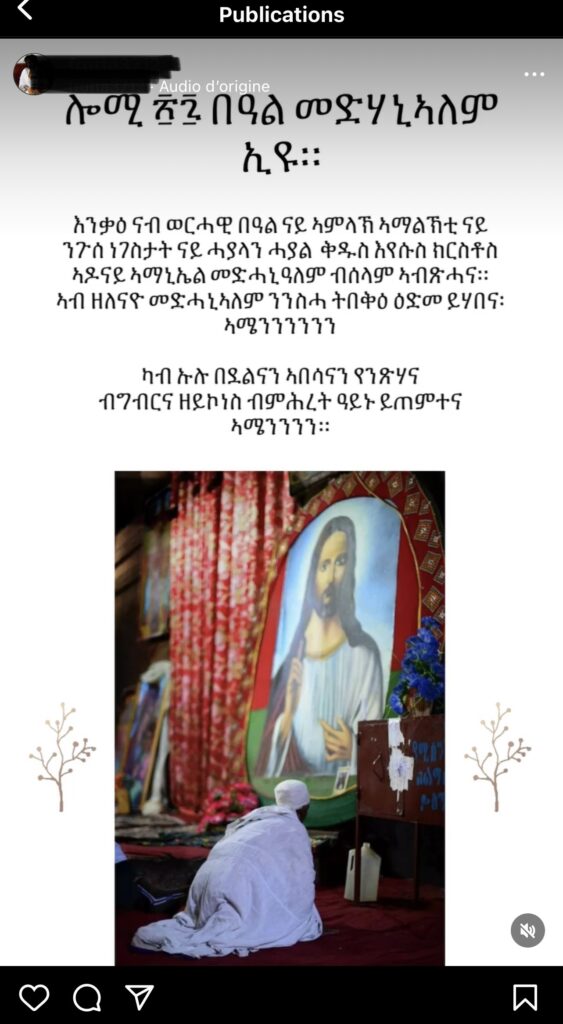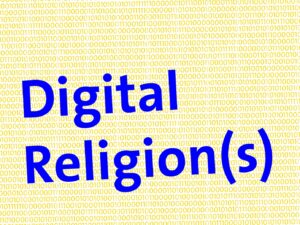For the research of the URPP subproject P5, which focuses on young migrants in Switzerland and their belongings to different religious local, transnational, or online networks, young people from different nationalities and religions have been interviewed. One of them is Mariam*, a 20-year-old Eritrean woman who came to Switzerland when she was 10 years old and is currently studying at high school. Mariam wishes to study hotel management so that she can open hotels in Eritrea to help her country develop. She is now very involved in the local Eritrean community in Switzerland. She teaches the Orthodox Christian religion on Saturday mornings to younger children and attends all the religious ceremonies in her church.
At the end of her interview, Mariam showed me her Instagram accounts: She describes herself as an Instagram influencer. Her first account is her „personal account“, where she posts pictures of herself, traditional recipes, information about her religion or her country or hair tips, for example. Her other account is her „official account“ dedicated to her religion: She shares sermons, verses and prayers, explains details about her religion, and even sings. As she explains: „Online, I share the verse of the day, or I talk about the differences between other religions and us, or I talk about history of religion… Actually, I just share. But I have this account where I clearly state that Christianism is ’this, this, or this‘… I focus on what is religion, what is around religion, what is inside religion… The stories, the exact dates when we commemorate special things or when we have to do specific things as well… Then, we also do the prayers. I share prayers, sermons, and songs too, I sing also. Actually, everything that represents my religion.“ Her motivation for having such an account is to share so that others can gain new knowledge. She currently has about 100 followers on the account.


Shortly before we met, she had a new idea: to create religious quizzes. So far, she has only conducted two of these. She is doing them in English and not in Tigrinya so that more people can participate. To prepare for the quiz, she dresses up in traditional Eritrean clothes, the ones women wear at church. Then she starts a live video on Instagram and asks quiz participants questions about religion, awarding them points and setting up a small competition. This game allows her to share various facets of her religion and even teach new elements to others in a fun way. Apart from these quizzes, she also organises live videos where she gives specific explanations about her religion, such as the differences between Catholics and Orthodox, important dates, or parts of the Bible. Participants can also react live with comments or „likes“.
The advantage of such online interactions is being able to share and really interact with people who have the same interests in such social media, often also of the same age. Indeed, when Mariam goes to church, according to her, it is to „pray and then leave“, as she has no time there to chat or exchange. Digital interactions allow for discussions that are „more educational than dogmatic“, she says. This is something that one of her friends, who was also interviewed, noted: „At church, you don’t discuss“, while platforms like Instagram offer the opportunity to ask questions you don’t know the answer to, to learn new thoughts and notions, or simply to discuss with each other. Social networks such as Instagram, therefore, provide a new perspective that complements the religiosity of some young people. Official ceremonies and rituals are most often held within institutions where the priest or the person who is the religious authority leads the ceremonies, in a rather hierarchical approach. Social networks allow new forms of religious interactions that could be described as horizontal.
However, it is important to note that in the sample of people I met, this kind of case was very rare. The majority of young people who have been in Switzerland as migrants or refugees for only a few years do not use social media networks solely for religious purposes like Mariam and her friend do. Rather, they use these platforms for an everyday use. First of all, religion is not necessarily important to all of them. Some of these young people are not religious, while others have gradually stopped practicing their religion since coming to Switzerland. For instance, Ali* (Eritrea) said: „Yesterday, so Friday, my friends say why we don’t go to Mosque, my answer is there is nothing to do with me, they don’t help you to integrate here, they don’t talk even about Switzerland, you know, it’s a religion thing, so they talk about stuff that happened one thousand years ago (laughing) I don’t care about this you know (laughing) so it’s just a waste of time for me.“ Thus, they have no interest in using digital platforms for religious purposes.
The majority of young refugees who are religious use social media platforms like anyone else. They use them to contact family and friends when possible, or to access content about various topics, such as sports, politics, make-up tutorials, motivational speeches, and international news. For example, when I asked Yasmin* (Afghanistan) about the content she follows on her favourite app, the first thing that came to her mind was the footballer Cristiano Ronaldo: „I use Instagram the most (…). I follow Cristiano Ronaldo, I like him a lot. There are also videos of Arabic singers that I love – things like that.“ While religious content may be a part of what they follow online, this is not a priority for the majority. These different examples illustrate that online platforms can be used to perform one’s religiosity in a horizontal way, but not exclusively. The reality is actually much more complex.
*pseudonym
Blogbeitrag von Virginie Fazel, UFSP-Projekt 5 Digitale Beziehungen und lokale Religionsgemeinschaften



